Yesterday I was waiting to have my name called for a nurse visit at the Beaumont (TX) VA Clinic. I listened to the cacophony of people’s names shouted out by folks in Primary Care mixed with those attempting to yell louder from the laboratory or X-Ray for patients. Soon, it hit me like a ton of boudain. This place has Cajuns up the wazoo.
A nurse would yell for “Mr. Breaux.” Then someone would holler “Mr. Led-ger,” her pronunciation for a Mr. Leger, which is most times spoken as “Lay’-jhay.” With those folks found, on the intercom came “Mr. Melancon please go to the pharmacy.”
I suppose I had me what us pseudo-intellectuals like to call an “epiphany.” I don’t know what my Cajun friends might call it, maybe an “epiphany.” Me, the pseudo-intellectual might say: “I had an epiphany this morning but I lost it in a paradigm shift.”
The northern part of Southeast Texas is where I was raised. I now live in Beaumont — the largest city in Southeast Texas if you don’t consider Houston as Southeast Texas — by way of Mississippi, the Western and Southern Pacific, as well as East and Central Texas. Now I must clarify the terms “East Texas” and “Southeast Texas.”
Folks down here in deepest Southeast Texas consider Jefferson, Orange, Newton, Jasper and Hardin counties as Southeast Texas. Okay, maybe even Tyler County. Now if you extend the boundaries of Cajun Country from the most southwestern Louisiana parishes into Orange and Jefferson counties, one might have to say the boundaries of Southeast Texas also include Calcasieu and Cameron parishes. Of course, we are talking cultural boundaries here.
I had a chief petty officer from Dallas who was master-at-arms, kind of like the head of the security guards, when I was stationed in Mississippi. We would argue to no end about what was and what isn’t in East and Southeast Texas. I said I was an East Texan. Because we didn’t have alligators and chemical plants where I grew up. But the chief said, “No that country is Southeast Texas.” After all these years, I have to say the chief was right (as always.) If geography didn’t make me a Southeast Texan, then I suppose demographics finally did.
We didn’t have many Cajuns where I grew up in northern Southeast Texas. Oh there were Cajun folks there. I had some good friends whose grandma spoke Cajun French. That was pretty exotic though. What happened was that some of the crackers in South Louisiana who saw the Cajun people as some kind of second-class folks. The Cajuns weren’t even allowed for many years to speak or learn Cajun French in school. Then in the late 60s, a cultural revolution that hit the rest of the country came to Louisiana. And, in the intervening years, many Cajun folks had moved to Southeast Texas, for jobs related to the petrochemical industry and shipbuilding. The latter being mostly during World War II and the former after the war.
When I moved back to the Golden Triangle — Beaumont, Port Arthur and Orange — I had to learn to pronounce many of the Cajun names I didn’t otherwise know. Why names like “Thibodeaux” and “Fontenot” (“the place is buzzing,” ‘ol Hank Williams sang.) take up considerable space in the “Greater Beaumont Area” phone book. Along with names like Chavez, Hernandez, and others I tried to correctly say I have somehow become at least partly apt at taking a spoonful out of the ol’ melting pot.
Some 40 years ago, I didn’t even know what boudain was, much less pronounce it. I remember when Mr. Latiolais (pronounced by him as “Latch’-o-lay,” some others with that name have different ways to say it) came to town and opened his supermarket called “Latch’s.” That was my first exposure to boudain and I fell in love even though some say “Ecchh” or “Nasty stuff.”
I have seen the Cajun culture grow in Southeast Texas, and around the country and even the world. Of course, we are part of Cajun Country even though we are Texans. So, yeah, there are quite a few Cajuns here. I am glad there are. I couldn’t imagine a world without Cajun cuisine or Cajun waltzes or Zydeco music. I know both states come with its baggage. Some of those first bags were made of carpet and we still see those types though they hide their bags. But this area of the country has become a much richer place to live.


